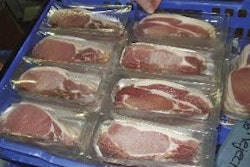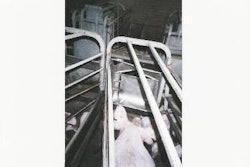.jpg?auto=format%2Ccompress&q=70&w=400)
As from January 2007 the Hampshire breed is no longer part of Denmark's national programme for genetic improvement of the pig breeding herd. Although a few breeders may continue with it voluntarily for their own commercial reasons, the Hamp is being phased out of official testing and its further use will not be supported by the breeding system operated by Dansk Svinproduktion (Danish Pig Production), the nationwide organisation responsible for activities with the primary sector.
The news was confirmed to about 2000 producers and advisers attending the latest national pig assembly held in Herning, Denmark, during a speech by Orla Grøn Pedersen, head of Dansk Svinproduktion. He made clear that the use of Hampshires had been declining nationally for at least the last 5 years, from a situation where the breed once represented up to 10% of the genes of the country's slaughter pigs to the point most recently where its share of this gene pool was no more than 4%.
"The Hampshire's share was never high and is even lower today," he comments. "I think we have seen a major decrease especially in the past 2 years that has coincided with the rise of PMWS or circovirus problems in our pig industry. Although it is something that is difficult to prove exactly, many people here believe that PMWS is worse in the progeny of Hampshire-crossbred boars and we have done some research that points in this direction too. There does seem to be a tendency in that way.
"It is the opposite of what we saw years ago, when the Hampshire was known as a good strong boar that gave healthy piglets. Now there are these doubts over its disease resistance specifically concerning PMWS. You cannot say this complaint relates only to Danish Hampshires because the same seems more or less true for all Hampshires worldwide. Nor would it be correct to suggest that the change has had anything to do with the improvement practices followed in Denmark. We have selected the breed on the usual parameters of daily weight gain, feed conversion and the maintenance of the meat content in the carcase. Certainly we have never pushed it in a certain direction that would have changed its basic ability to resist disease challenges."
"But do not think that PMWS alone has been the reason for our decision," Orla Grøn continues. "The Hampshire was always a nice breed to include in a crossbred boar that would be active in natural mating and detecting sows on heat. Now that artificial insemination has taken over, however, these attributes are less valuable than they were before. Even more important in our view is that our experience has shown no advantage in using a Hampshire-Duroc crossbred rather than a purebred Duroc as the terminal sire, in terms of the progeny obtained. This was really the main argument against the breed and the most compelling reason for deciding to stop including it.
"We calculate that the national breeding system will save quite some money because of the decision. The breeders who had Hampshires did not sell many boars apart from a few supplied to the AI centres and breed also tended to give a low litter size. All this meant they incurred extra costs, of course, so the inclusion of the Hampshire was subsided in practice by the 3 other breeds we use: the Danish Landrace, Danish Large White and Duroc. By our calculations the saving in cost will amount to nearly 2 million, so it is quite significant."
He reports that the 9 nucleus herds with Hampshires in the national breeding programme in Denmark have almost 800 sows between them, compared with the 3450 sows in Landrace herds, 2750 Large Whites and 1800 Durocs. The phase-out of their links to the official programme will take another 12-18 months to complete, according to the terms of the contractual agreements under which they have operated.
After that, Orla Grøn suggests, perhaps 3-4 breeders will opt to continue keeping some Hampshires of their own accord to satisfy the residual sales potential nationwide for purebred or Hamp-cross boars. But the removal of the other sows will not be covered by compensation because the herds concerned are not considered to be incurring losses. Many will be interested in converting to multiplication for the white breeds, he remarks. Being a multiplier is good business in Denmark these days as the demand grows rapidly for Landrace/Large White herd replacement gilts. He adds that there are no plans at present to maintain the overall size of the nucleus sow population by increasing Landrace, Large White or Duroc numbers to make up for the loss of the Hampshires.PIGI

















